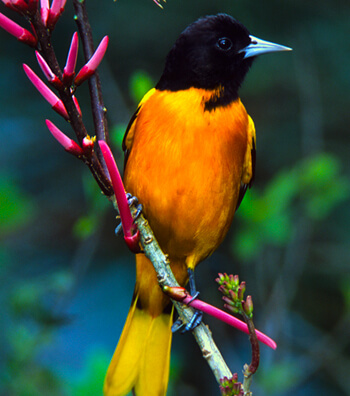EPA Cancels Registrations of Two Bird-Killing Pesticides
 |
| Baltimore Oriole by Ralph Wright |
(Washington, D.C., March 1, 2012) The U.S. Environmental Protection Agency (EPA) has announced the cancellation of two toxic pesticides that were documented by American Bird Conservancy to have recurrently poisoned hundreds of birds.
“ABC has repeatedly raised concerns with the EPA about the toxic impacts of both dimethoate and methidathion on some of America's migratory bird species that feed in fields where the pesticides are used. There are a number of less toxic, widely-available, and equally effective insecticide alternatives that can be used by our nation's farmers, and so we applaud the EPA for taking these final steps to cancel the registered uses of these harmful chemicals,” said Darin Schroeder, Vice President of Conservation Advocacy for American Bird Conservancy, the nation's leading bird conservation organization.
Dimethoate is an insecticide used on many different food products including blueberries, a fruit often eaten by birds such as Cedar Waxwings and Baltimore Orioles. ABC's records show multiple poisoning incidents by this chemical resulting in over 600 bird fatalities. ABC has repeatedly requested EPA to revoke import tolerances for dimethoate and twelve other chemicals – meaning that food containing residues of the pesticide would no longer be allowed to be imported into the United States. ABC believes that as long as such tolerances exist, the use of these pesticides will continue on crops grown for export in Central America, where many migratory birds spend their winter.
Methidathion is used to control a variety of insects and mites in many crops such as fruits, vegetables, tobacco, alfalfa, and sunflowers. ABC's Avian Incident Monitoring System (AIMS) database shows that it has been associated with numerous hawk poisoning incidents. Data on deadly encounters involving birds and chemicals is documented by the AIMS database, a centralized source for field data on lethal and sub-lethal impacts of pesticides on birds. Unfortunately, while the system had provided documentation on such incidents dating back to the 1980s, in 1998 the EPA relaxed reporting rules on pesticide poisoning of wildlife to the point where they are now effectively meaningless.
“Of the five billion pounds of pesticides that are applied worldwide each year, 20% is used in the United States. The assumption that because these pesticides are licensed by the federal government their use is automatically safe is unfounded. In fact, pesticides like dimethoate and methidathion continue to cause significant bird mortality each year,” said Schroeder.
In 2002, American Bird Conservancy formed the National Pesticide Reform Coalition (NPRC) to improve collaboration between conservation organizations on pesticide issues and increase their influence on regulatory decisions. ABC leads this coalition, which numbers more than 20 partner groups. Over the last decade, ABC and NPRC efforts have led to the cancellation of over a dozen pesticides that are particularly harmful to birds, including fenthion, chlorfenapyr, ethyl parathion, and carbofuran. These combined restrictions have caused bird deaths from pesticide poisonings to drop dramatically from an estimated 67 million birds per year in 1992 to perhaps fewer than 15 million per year today.


















































